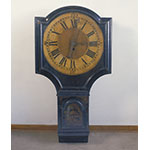The varnished and lacquered wooden case is of the English "shield" type. The lower part of the clock has a door decorated with a lacquered Chinese landscape. Opening the door gives access to the pendulum and driving weight. In the compartment behind the dial another door gives access to the movement. The ends of the upper cornice carried two small ornamental vases or knobs, for which the housing holes remain. The large dial originally had a black background with gold numerals and line markings, still visible. The hands are replacements. The winding hole is just under the center. The train comprises four wheels, including the main wheel on the axle of the rope-winding drum and not counting the escapement wheel. The rugged steel escapement is an anchor version. The seconds pendulum has a spring suspension and brass crutch. The rod ends in a hook to which was attached a weight (missing) less cumbersome than the bob. This design is well known. It is often referred to as an "Act of Parliament Clock" because of a misinterpretation of a tax introduced in 1797. Its standard name is "tavern clock" and the size of the dial certainly made it suitable for large public premises. As it could be hung from a safe height and had a short case, it was protected from potential damage from overcrowding in the locale where it was installed.










